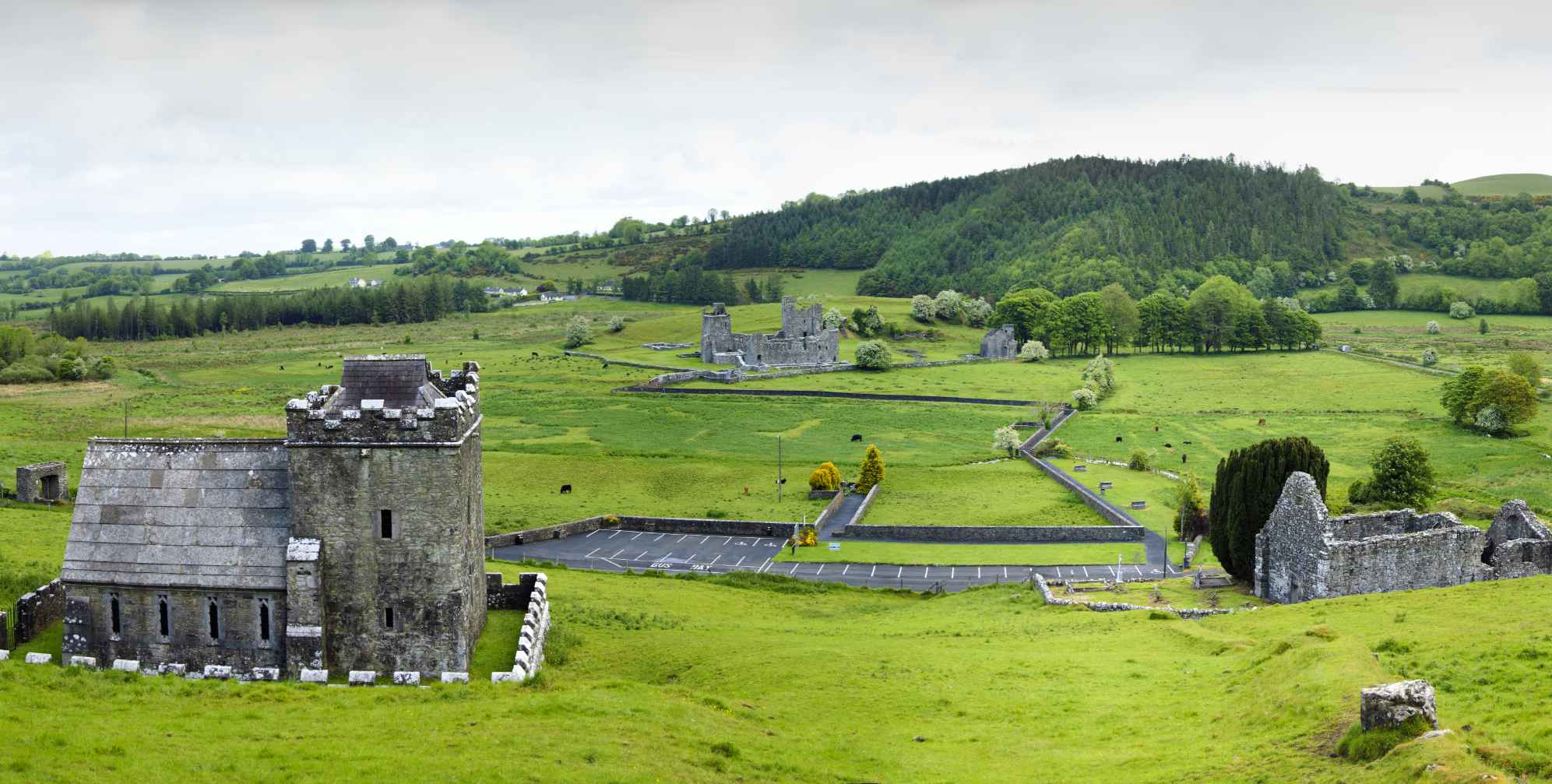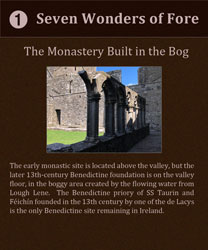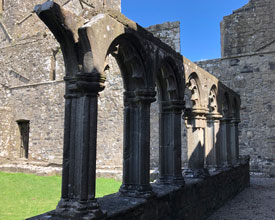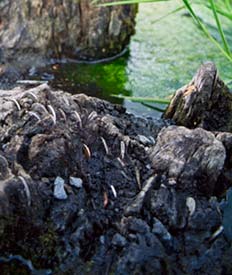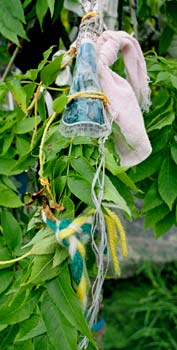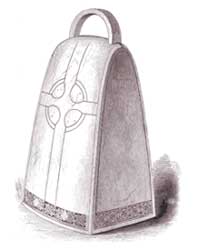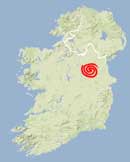20 Aug The Seven Wonders of Fore
1. The Monastery Built upon the Bog
2. The Mill Without a Race
3. The Water that Flows Uphill
4. The Tree that Won’t Burn
5. The Water that Doesn’t Boil
6. The Anchorite In a Stone
7. The Lintel Stone Raised by St. Féichin’s Prayers
The Seven Wonders of Fore are explained in detail below and also on the numbered brown “information boards” to be found in the VR tour. View in full-screen mode to read the text on these.1
However the most astonishing wonder of today’s little village of Fore—tucked away on a sleepy byway 4 km (2.5 mi) east of Castlepollard—is that it once was a bustling monastic town of some three thousand monks, drawn from many countries to the fortress-like Benedictine abbey dedicated to SS Féichín and Taurin. The town was once so renowned for its erudition that it was called Baile Leabhair, “The Town of Books.”2
But the great Norman abbey on the valley floor was not the first foundation of St. Féichín to be established here. On the southern hillside, looking down on the sprawling Benedictine ruins, lie the remains of a much older church, in tradition built by St. Féichín himself around the year 630. According to one of the hymns for the Office of the Saint’s Feast, the little church grew into a community of more than 300 monks and 2,000 students by the time the holy man contracted the Yellow Plague and died on the 20th of January, 664.3
St. Féichín was born c. 585 in Co. Sligo and was known even during his childhood for living a life of asceticism. Trained by St. Náth Í of Achonry, Féichín came from the family of a noted chieftain. Before settling in Fore he founded a church which ultimately became Ballysadare Abbey in Co. Sligo. He also founded the monastery of Termon Féichín, near Drogheda, as well as monastic settlements on small islands off the Galway coast, where “he was the first man to preach the Gospel, and baptize the inhabitants.”4 According to one account, the rule in St. Féichín’s Monastery was severe, with the holy founder setting the highest example:
“The Hospitable Féichín of Fobhar loved,
It was not a false mortification,
To lay his fleshless ribs upon the
Hard rocks without clothes.” 5
St. Féichín’s old church on the hill, in legend attributed to the seventh-century saint, likely dates from the late ninth century and replaced an earlier structure. The building is 18.3 m (60 ft) long and 7.2 m (23.6 ft) wide. The chancel was added in the early 13th century; the east window dates to the 15th century. Inside the church are early grave-slabs, a font, and the remnants of an altar. The most notable feature of the church is the impressive western doorway, with its massive 2.27-tonne (2.5-ton), 183-cm (6-ft) long lintel stone, boldly inscribed with a Greek cross inside a circle. This may be seen on one of the “information boards” in the VR tour at the top of the page.
There were originally two other ancient churches, now destroyed, located nearby. The scene was not always as bucolic as it seems today, as Fore was burnt a dozen times between 771 and 1169. Ninth-century Vikings from nearby Ballania, led by Turgesius, may have done their share of the pillaging.6 Can this explain the discovery of a seventh-century bell in a nearby lake (see below)?
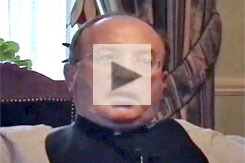
V. Rev. Fr. Patrick Moore, the parish priest in Castlepollard, talks about the traditional beliefs associated with holy wells. (1998)
The Benedictine Abbey of SS Taurin and Féichín, dominating the marshy valley, is mostly of early 13th-century construction, with its dormitory towers added in the 15th century. The monastery was sponsored by Walter de Lacy, whose family had seized the area around 1180. It was built around a central cloister, with its church to the north, dormitories for its monks to the east, and the refectory and kitchen to the south and southwest. A visitor in 1837 noted that red-tinted plaster was still evident on the walls at that date.7 A section of the graceful cloister arcade, re-erected in 1912, may be noted on one of the “information boards” in the VR tour. To the northeast of the main structure, visible in our aerial VR view of the abbey, are the remains of a circular pigeon-house, or dovecote.
De Lacy established the monastery as the property of the Abbey of St. Taurin at Evreux, in Normandy, which eventually caused the Fore monastery to be targeted as an “alien property” during the Anglo-French wars of the 14th century.8 Perhaps because of the sporadic conflicts, a 15th-century fortified tower was constructed at the western end of the priory, its defensive design made clear by the arrow slits in the walls and the “murder hole” above the gateway, from which the defenders could drop rocks or boiling oil.
The medieval walled town of Fore grew up around the abbey. A massive archway gate of this wall survives, seen beside the road just west of the village. Also surviving, in differing states of weathering and decay, are the 14 Fore Crosses, spread around the village roadways and fields. These may have once played a role in pilgrimage rounds on St. Féichín’s feast day (January 20th), and were used as prayer stations for 18th and 19th century funeral processions.9
After Henry VIII’s 1531 reformation laws, and the subsequent 1536 acts dissolving the monasteries, the abbey at Fore was granted on September 30th, 1588, to Christopher Baron Delvin, known locally as “The Black Baron,” and the properties stayed within his family until the modern era. The baron’s soldiers, however, ransacked and torched the Abbey, removing anything of value. What they missed, the townspeople then claimed. A writer in 1835 imagined the scene:
“What fire and sword, however, spared, the pilfering hands of the building gentry of the neighbourhood completely removed. Not a door-frame, quoin, squared or ornamental stone, or window mullion or tracing remains, except part of the eastern window of the chancel. The famous abbey is now, paradoxically speaking, a ruin of a ruin.” 10
The construction of the Benedictine abbey, with its Norman architecture and rituals, ended the thousand-year influence of the indigenous Celtic Catholicism as practiced at the early monastic site of St. Féichín. The new arrivals assumed the lands, tithes, and farms of St. Féichín’s ancient foundation at Fore. The secular authorities of the Reformation, in turn, evicted the Benedictines. In John Colgan’s 1645 Life of St. Féichín, a story illustrates the animosity that must have existed between the local Irish and the English Pale usurpers of religious life in the valley:
“A certain Englishman was vicar of St. Féichín’s Church. This man, detesting the Irish people, was accustomed to abuse St. Féichín, the patron of his church, with special contumely [contempt]. But on a certain day when he entered the Church of St. Féichín, and knelt before the altar, a tall cleric approached to him. His body was emaciated, his appearance terrible, his face red with anger. The unknown rushed at the vicar as a blasphemer, and struck him violently upon the chest with the staff he held in his hand. The vicar, astonished by his appearance, and sick on account of the intolerable blow, at once returned home, declaring that his assailant was St. Féichín whom he had abused and derided. As soon as he got to his house he took to his bed, and died in three days.” 11
St. Féichín’s presence continues to influence the community of Fore, although in ways that the pious penitent of the seventh century might not have imagined. While it’s unclear when the particular phrase came in vogue, today most tourist brochures, travel books, web resources, and visitors’ blogs make reference to the same seven features of the holy man’s valley, each tied in some way to St. Féichín.
The Seven Wonders of Fore
1. The Monastery Built upon the Bog
The early monastic site is located above the valley, but the later 13th-century Benedictine foundation is on the valley floor, in the boggy area created by the flowing water from Lough Lene. The Abbey of SS Taurin and Féichín, founded in the 13th century by one of the de Lacys, is the only medieval Benedictine site remaining in Ireland.12
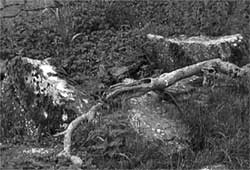
The Doaghfeighin well, also known as “St. Féchín’s Bath,” may have originally been a megalithic cist burial.
2. The Mill Without a Race
It is said that St. Féichín built his mill here where there was no water, even though his carpenter scoffed at the idea. After the mill was completed, the saint thrust his crozier into the ground and the water from Lough Lene began to flow. Soon the torrent grew sufficient to operate the mill. The doubting carpenter, who was sleeping in the mill, was drowned in the deluge. But St. Féichín restored him to life. According to his hagiographer, the mill was “hewn by the saint’s hands, on the side of a rock, within which as also the church, women do not enter.” According to local tradition, the mill was still being used until 1875, when it was replaced. The triangular millpond is now mostly silted up, but the springs that once filled it, whether created by the saint or not, still bubble up nearby.13 An old sonnet exclaims:
“To Fore West let us go,
That valley lying low,
And see the rill,
That, thro’ the hill,
To turn the mill,
St. Féichín caused to flow.” 14
3. The Water that Flows Uphill
Standing in the valley, an optical illusion makes the flowing stream, brought to life by St. Féichín’s staff, appear to flow uphill. The village of Fore takes its name, Fobhar Féichín (St. Féichín’s Spring) from that “wonder” which flows underground from Lough Lene, a mile away and on the other side of a mountain, and springs up in the valley beside the ancient church. John O’Donovan suggested that the original name of the site, prior to its association with the saint, was Gleann Fobhair, or “Valley of Streams.”15
4. The Tree that Won’t Burn
Also known as “The Tree with Three Branches,” the ancient ash in the Tobernacogany well was also named “The Money Tree” since many generations of pilgrims hammered copper coins into its bark. This practice may have led to the death of the venerable tree, now replaced by the sapling seen in the VR tour, festooned by pilgrims with colorful rags and personal mementos rather than copper coins. A local informant in 1987 remembered, “when his mother was a young woman, a man chopped off a branch of the tree for firewood and the next day was found dead.”16
5. The Water that Doesn’t Boil
There are two holy wells associated with St. Féichín. Doaghfeighin (St Féichín’s Bath) was where the saint knelt and prayed while immersed in the cold water. See photo, above right. At one time sickly children were immersed in the well to obtain a cure through St Féichín. This well may have originally been a megalithic cist burial. The other well is known as Tobernacogany, which may mean “The Well of the Kitchen.”17 Its waters were reputed to heal the sick, curing headache, toothache, and other infirmities. It is said that the waters of this well will not boil, and the old people tell of the dire misfortunes that befell certain rash incredulous ones who made the experiment. Up to the end of the 19th century stations were performed here on St. Féichín’s Day (20 January), St. John’s day (24 June), and St. Peter’s day (29 June).
6. The Anchorite In a Stone
On the climb up the hill of Carrick Balor above St Féichín’s church there is a 15th-century tower attached to the 19th-century mausoleum of the Grenville-Nugent family. Inside the tower is the anchorite’s cell, the retreat of the last religious hermit in Ireland, perhaps the “last of the order in Western Europe.” The hermit was named Patrick Beglin, and once he entered his cell he never left, praying and meditating in his small dark space, with food and water brought to him by local supporters. An inscription in the chapel says his body is “hidden in the hollow heap of stones.” Beglin fell and broke his neck while climbing down from his cell, thus fulfilling his promise never to leave the tower alive.18 Of the anchorite’s daily routine, a text published in 1682 reported:
“He is said by the natives, who hold him in great veneration for his sanctity, every day to dig, or rather scrape—for he useth no other tools but his nails—a portion of his grave…The only recreation this poor prisoner is capable of is to walk on the terrace built over the cell wherein he lies, if he may be said to walk, who cannot in one line stretch forth his legs four times.” 19
7. The Lintel Stone Raised by St. Féichín’s Prayers
When St. Féichín’s church was being built the workmen were laboring for hours to raise the massive 2.27-tonne (2.5-ton), 183-cm (6-ft) long lintel stone, but to no avail. St. Féichín told them to go home to breakfast and then began to pray. After some time spent in prayer, the saint took the stone in his arms and without any difficulty placed it over the doorway. This huge lintel, inscribed with a Greek cross within a circle, is still in place above the west doorway.
The Wonders in Perspective
From an economic point of view, The Seven Wonders of Fore function as a narrative designed to entice visitors to this off-the-beaten-track destination, where the only other reason to stop might be an evening seisiún (impromptu music) at the Abbey House Bar and Lounge. But the Seven Wonders also illustrate how the early Celtic Church, and indeed some contemporary Catholics today, are able to blend seamlessly native folk practices, such as tying rags onto a tree by a holy well, into their Roman Catholic faith. As Fr. Patrick Moore, the parish priest in the nearby town of Castlepollard, noted (video, above right):
The early Christian saints, guided by St. Patrick’s example, would have Christianized these practices. But there’s a very deep tradition in the peoples’ hearts about it. They had a basic similar thrust like the pagan ones, aimed toward God towards the divine. Once they enlarged or enriched what the Christian guidelines or principles were, the Church would have no difficulty with them.20
An author in 1927 observed, “Christianity took hold upon the Irish because it was offered to them in a form almost as much pagan as Christian.”21 The fifth-century missionaries to Iron Age Ireland presented the lives of their saints in a framework of miracle working with anecdotes equal to, or superior to, any magic of the pagan gods. While the Church presented the Eucharist as the preeminent miracle of the Faith, the peasant of Ireland experienced his own encounter with the sacred during his “ordinary course of popular devotions.”22
Thus it is that many other Early Christian sites in Ireland have their own lists of wonders, if not Fore’s full complement of seven. Holy wells abound, each with its specific curative powers. Some wells have, in tradition, gone a step further: at Skellig Michael, a stone cavity outside the church “every morning, through the merits of the saint to whom the church is dedicated, is filled with as much wine as will conveniently suffice for the service of the masses…”23 At the Tullaghan Hill Holy Well, the water was said to rise and fall with the tides, even though the well was miles away from the seacoast. The story of the pair of enchanted trout living in that well, fish that never grow old, was told elsewhere around the country.
For hundreds of years after the Norman invaders imposed their own religious supremacy on the Celtic Church the old traditional practices continued among the common people of Ireland. And later, after the sanctions of the Penal Laws at the start of the 17th century hobbled the Catholic hierarchy’s attempt at reforming the old Celtic ways, the folk practices of the faithful continued unabated.24
St. Féichín would have been pleased on May 23, 2010 when, as part of the Jubilee Pilgrimage and to celebrate the Year of the Priesthood, more than 400 people from nine parishes gathered in a procession from the Fore Church to the ruins of the Benedictine Abbey. Led by the Blessed Sacrament, the crowd took an hour to cover the distance on a day of full sun and unseasonably high temperatures. They circled the Abbey, with representatives from the different parishes taking turns carrying the holy vessel, accompanied by prayers and songs from the assembled choirs. Local school children, the youngest in full communion dress, made large banners to hold aloft during the procession.25
In 1881 a boy fishing for eels on Lough Lene’s Castle Island, the ancient redoubt of Turgesius the Viking, discovered what might have been St. Féichín’s ceremonial bell (above, right). The Norse warrior may have stolen this relic of the saint from the Fore church in a ninth-century raid. Although the original bell is now in the National Museum, a half-size replica was given to the Dáil Éireann (Irish parliament) in 1931. The Ceann Comhairle (Chairperson) rings the bell to restore civility whenever deputies are out of order. St. Féichín would have been pleased.26
Click here to see all the notes from this page.
The Seven Wonders of Fore, Co. Westmeath
Nearest Town: Castlepollard
Townland: Fore
Latitude: 53° 40′ 48.71″ N
Longitude: 7° 13′ 45.05″ W



